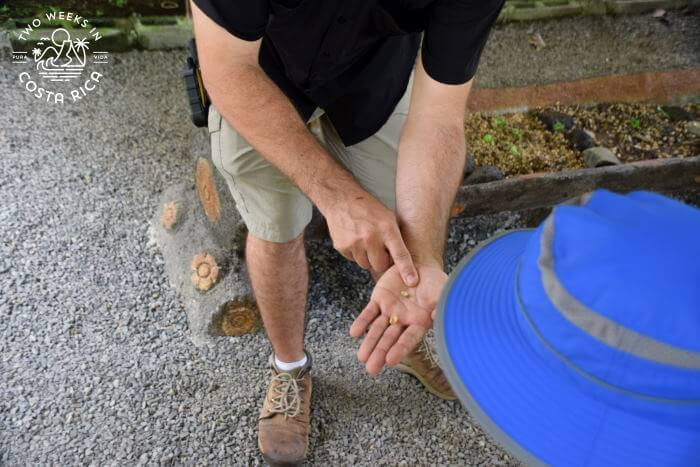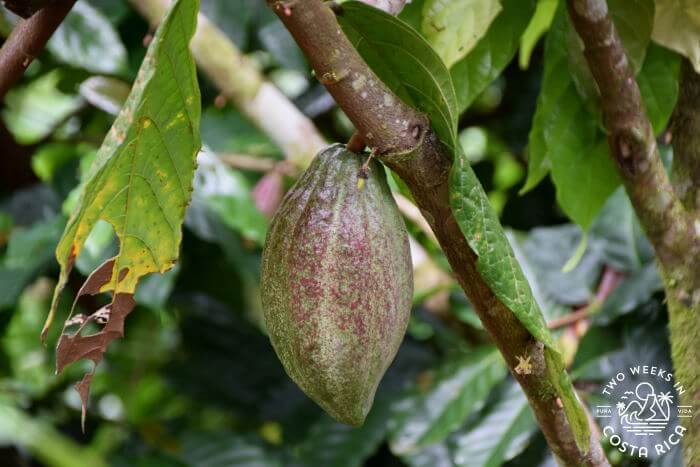Last Updated: April 30, 2024
Coffee and chocolate are two of the crops that Costa Rica is most famous for. In fact, Costa Rica’s fine Arabica beans have won competitions across the globe. You may have tried some of this specialty coffee from your local grocer, but it is completely different to taste a cup straight from the farm. In this post, we’ll tell you about our visit to North Fields Café. This small farm in La Fortuna offers tours where you’ll learn how coffee and chocolate are made. You’ll also get to enjoy plenty of delicious tastings at the end!

Background
Coffee and chocolate tours are available in several different destinations in Costa Rica. La Fortuna/Arenal, in the country’s Northern Highlands, is one of the best places for these tours. There are several tours to choose from here. Each offers a slightly different experience.
North Fields Café is a nice balance. They have a family-owned farm just outside downtown La Fortuna. Their tour includes both a chocolate and coffee tasting component so it’s a good option for kids and adults alike.
North Fields Coffee and Chocolate Tour
Walking the Fields
Our tour began in the coffee fields right across the street from their small office. Alan, our guide and a local from the area, walked us along the well-maintained path.
Alan started by pointing out red and green coffee beans growing from the tall, shiny plants. Since we visited in June, it wasn’t harvest season so most of the coffee cherries we saw were green, but we did see a few ripe red ones.

On the farm, they grew many varieties of coffee. Alan told us about one called Geisha. This type has hints of tea and is favored in the eastern part of the world. In the coffee market, Geisha is one of the most expensive types. A Panamanian grower sold just one pound for over $1,000 in 2019!
In addition to coffee, at North Fields, they also grow cacao plants and many fruits, vegetables, and spices.
For tropical fruits, we saw pineapple, seven types of bananas, and guanabana (soursop), a funky looking green fruit with soft spikes and creamy white flesh. Some other interesting things were hot peppers, vanilla, and elephant-ear plant (taro root).
Learning How Coffee is Produced
After a few minutes, we stopped to sit in a covered area where Alan started teaching us about how coffee is made.
The coffee plants start in a nursery. Alan, we learned, has an intimate knowledge of this part of the process.
As a kid, he used to help grow coffee plants and sell them to local plantations. He shared memories of adding soil to bags and planting coffee seedlings in them. Alan has been in the coffee business his whole life, more or less, so we learned a lot from him.
After the coffee plant has had some time to grow, it is transplanted into the fields. Once the plant reaches maturity and begins producing coffee, the coffee cherries are harvested. This is a time-consuming process. In most coffee farms in Costa Rica, harvesting is still done by hand.
After the red cherries are harvested, they are ground to remove the skin from the white beans inside. These white beans will then be dried and roasted into coffee beans.

Learning How Chocolate Is Made
We also learned about the chocolate-making process.
We got to see the strange-looking pods growing out of short, but strong-looking, trees. Inside the hard, colorful exterior were rows of seeds covered in a thick white pulp. (See cover photo, above.)

These seeds go through a fermentation process. Then, similar to coffee, are dried and roasted. Once roasted, they turn the familiar brown color that we know as chocolate.
Chocolate Tastings!
Back at the office, Alan brought us to a small room and told us to take a seat at the rustic wooden table.
In front of us were little ceramic containers, a small metal container, wooden bowl, and a glass of water. We were going to get to start tasting chocolate.
Alan started a demonstration along with another guy named Christian and Christian’s father. He ground the cacao beans using an old-fashioned machine, then put some of the coarse chocolate into a special grinder. The chocolate needs to spend quite a bit of time in this machine to reach a smooth consistency.

Luckily, Alan and his team had some chocolate already made and ready.
They started bringing out small chunks to each of us and told us that we would be playing a game. We would need to guess which chocolate was the darkest, from 60% to 85%.
We like dark chocolate so it was easy for us to know which one was the 60% with the most sugar. Our young kids picked out the 85% right away, their faces grimacing. It was definitely too bitter for them!
After enjoying lots of delicious chocolate, we then got to mix some ourselves. In our metal cup, we could add sugar for sweetness and powdered milk to get a creamier consistency. They also invited us to try spices such as vanilla, cinnamon, cayenne, and salt. The raw taste of the freshly ground cacao was divine, especially when we added some of our favorite flavors.

Coffee Tastings!
Roasting the Beans
With our stomachs full of rich chocolate, it was time to learn about the next steps for making coffee.
Alan added some dried beans into a huge stone roaster. They had made this for demonstration purposes to give an idea of how coffee was processed in the old days. Christian placed the metal drum over a fire, continuously turning it so that the beans would roast evenly. After a few minutes, we began to smell the strong aroma of coffee.
They kept checking the color of the beans, then at the precise moment when they were the right color, Alan released them into a metal base with holes and stirred until they cooled.

Now roasted, these beans were ready to be made into coffee.
Brewing Coffee
Alan walked us over to their small coffee bar and talked about how to make a good cup of joe.
As people who drink coffee multiple times a day, we loved hearing his insight into what it takes to make the perfect cup.
He showed us how coffee is made the traditional way in Costa Rica using a device called a chorreador. This is basic wooden stand with a cloth filter. You put enough coffee in the filter for one cup, then pour hot water over it, letting the coffee slowly percolate into the cup below.
Alan explained that chorreadors are sort of nostalgic in Costa Rica. They are something that most Costa Ricans remember from childhood and seeing one in their abuela’s (grandmother’s) house.

Alan then explained other methods of preparing coffee, including the common drip method, French press, and Chemex brewer.
Finally, the coffee was ready, and we got to taste some for ourselves.
Alan had brewed some of their medium and dark roasts. We tried the medium, black of course, so that we could taste the flavor profile. It was delicious.

Alongside our coffee, they gave us some simple arepas to help absorb the chocolate and caffeine that filled our bellies.
Conclusion
We have done many coffee and chocolate tours in Costa Rica and thought that North Fields was one of the best. They have a nice balance of learning about the production process and getting to enjoy some of the (delicious) results. The chocolate and coffee tastings were elaborate and fun to experience!
Booking the North Fields Coffee Tour
If you’d like to book a tour, please use the links below and we’ll take care of all the details for you. You won’t pay until the reservation is confirmed, and we’ll email you as part of the process. Booking through us costs the same and helps support our website!
Tour Times
North Fields does tours daily at 8:00 a.m., 10:00 a.m., 12:30 p.m., 2:00 p.m., and 3:00 p.m.
Cost (2024)
$43 per person adults
$33 per person children ages 6-12
Free for children ages 5 and under

Duration
2.5 hours (approximate)
Includes
Round-trip transportation from hotels near downtown La Fortuna (if needed), bilingual guide, and tastings.
Have a question about coffee and chocolate tours? Leave us a comment below.
Last Updated: April 30, 2024
Looking for more information to plan your trip to La Fortuna? Check out these posts:
La Fortuna Tours: Check out more of our favorite activities in the area. We can help you book them for free.
A Safari River Float in La Fortuna/Arenal: This is another fun activity in the area. It’s good for the whole family and an easy way to see wildlife.
Night Tour at Arenal Oasis: Read about our experience on the night tour at the Arenal Oasis Reserve. We got to see lots of frogs and even snakes.
Vacation Rentals in Costa Rica: Safety and What to Look for – Thinking of renting an Airbnb? Check out our article for Costa Rica-specific tips.

